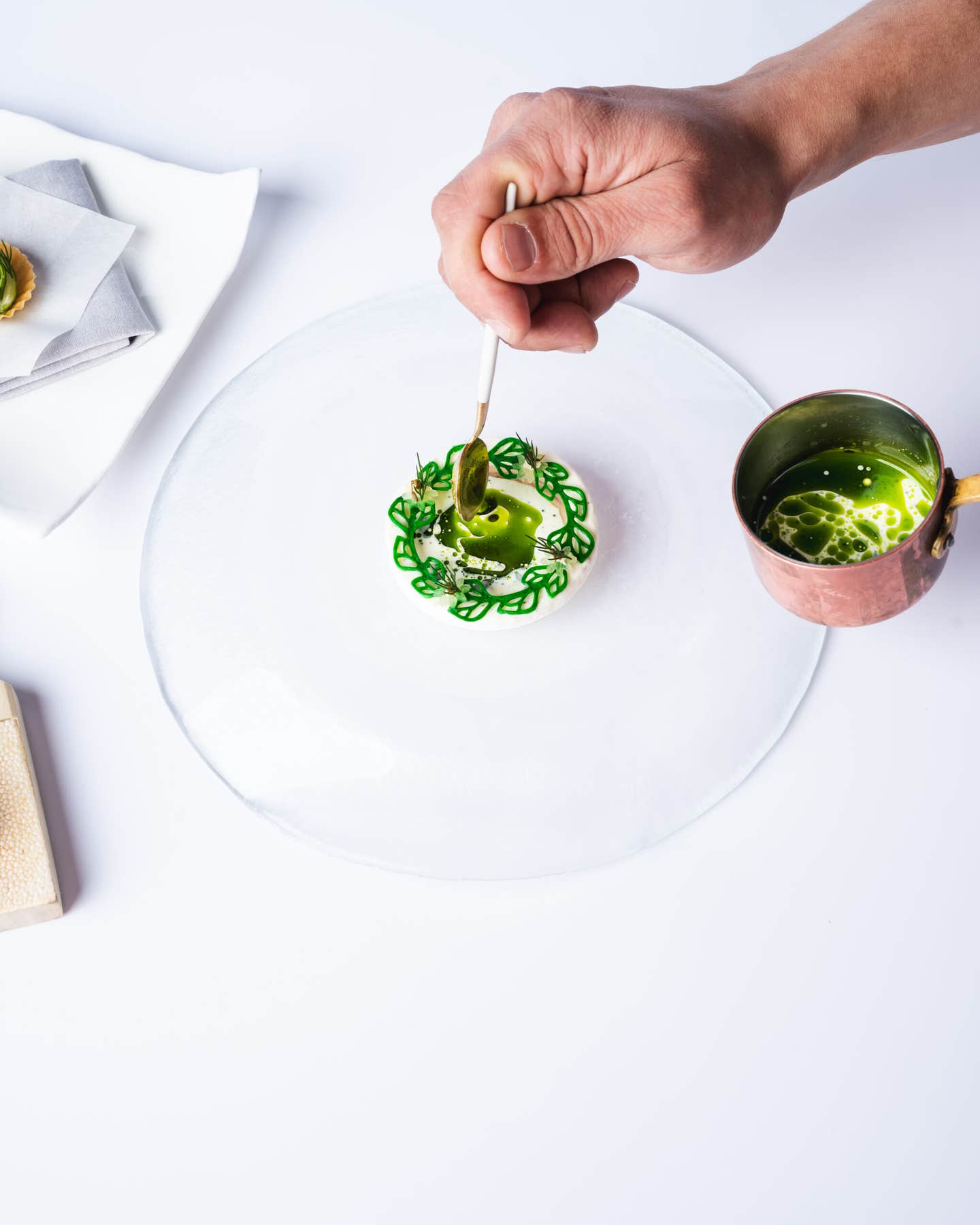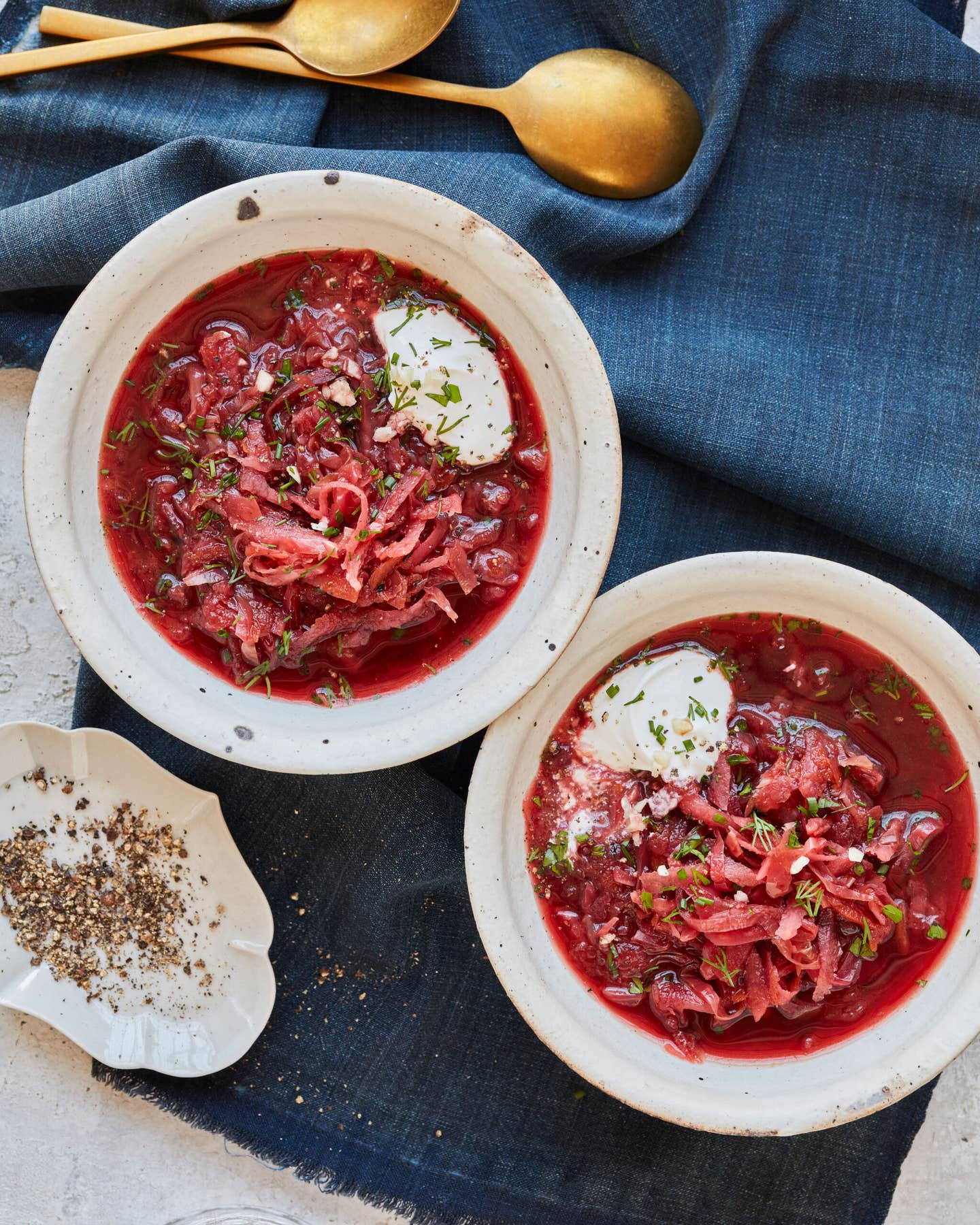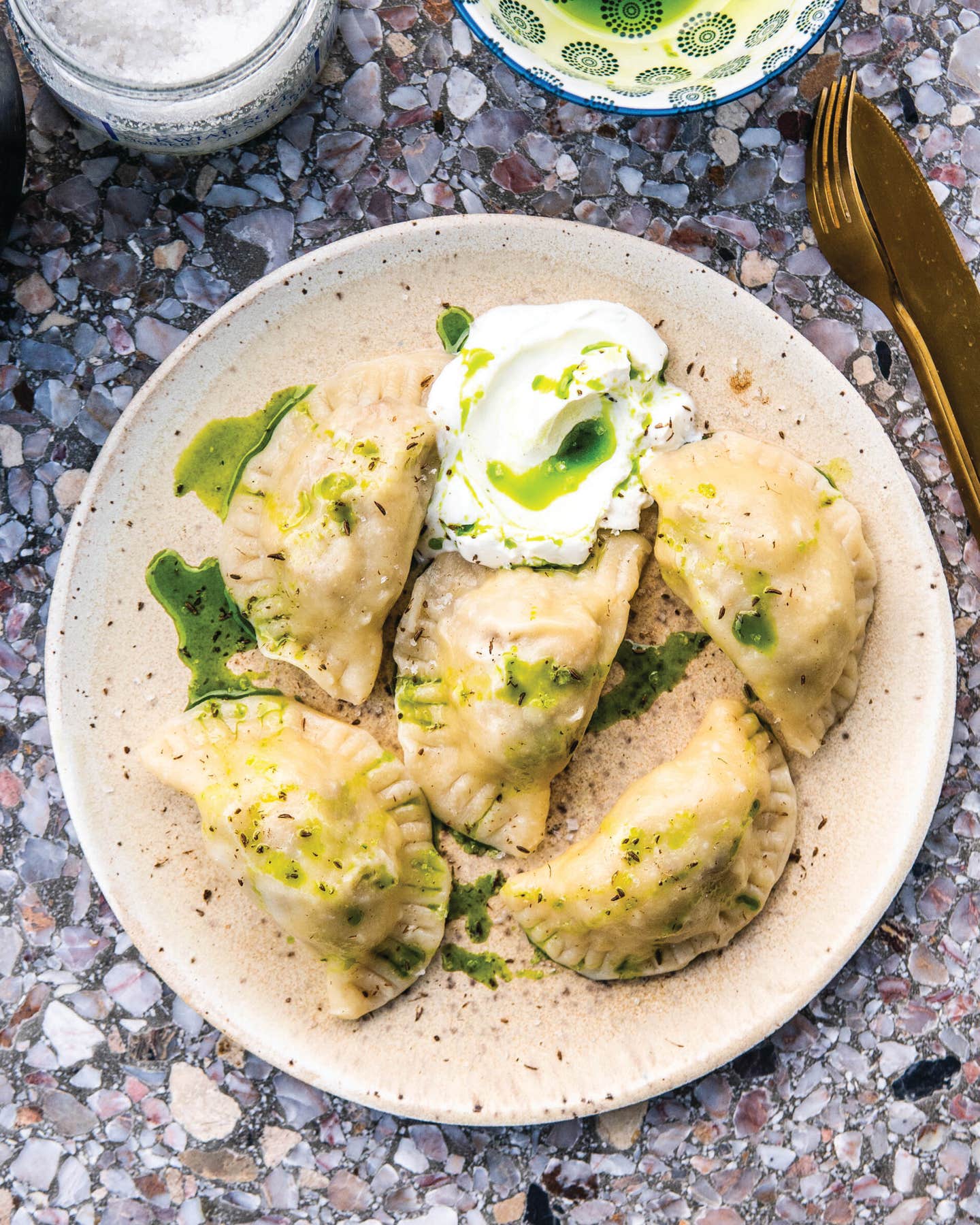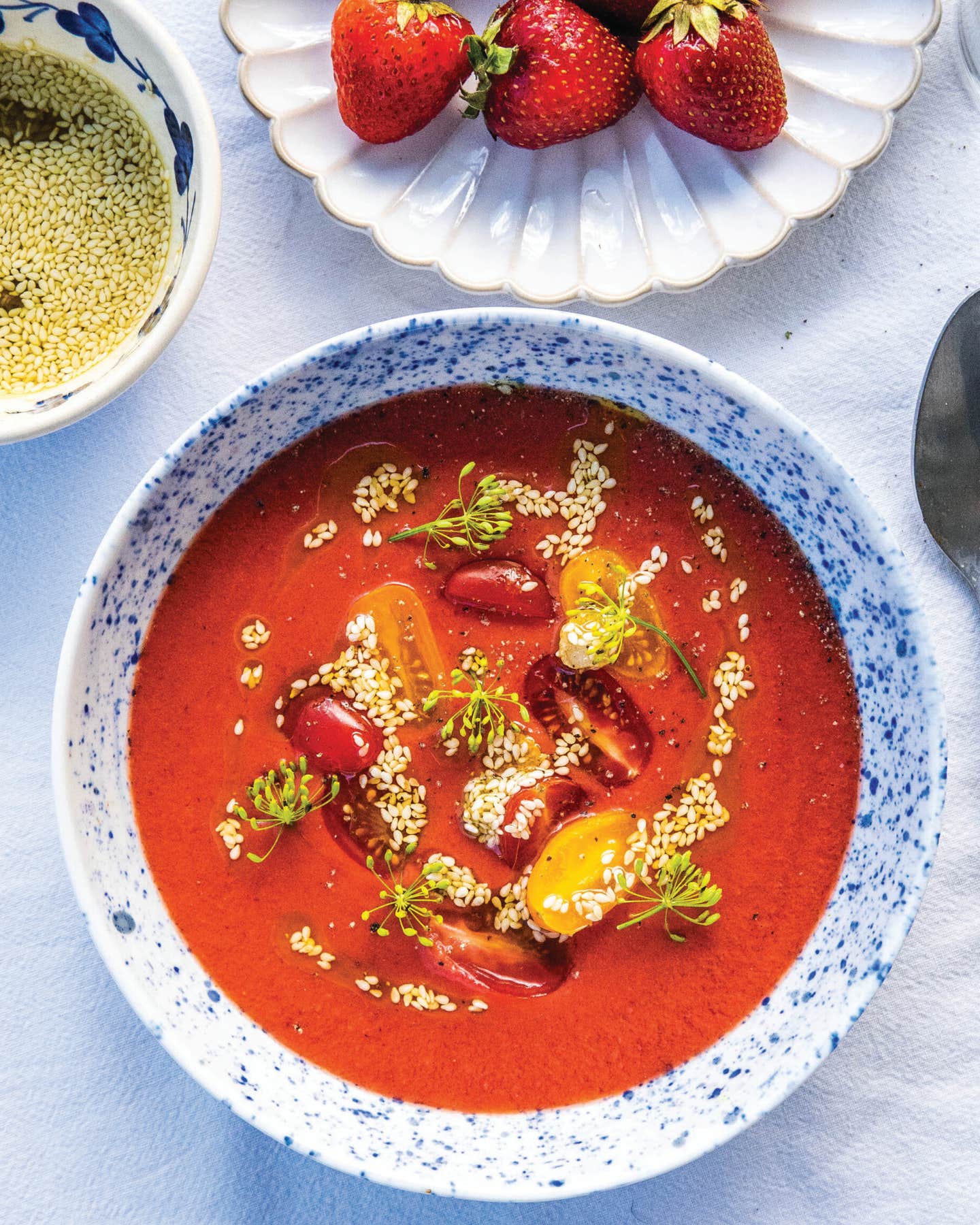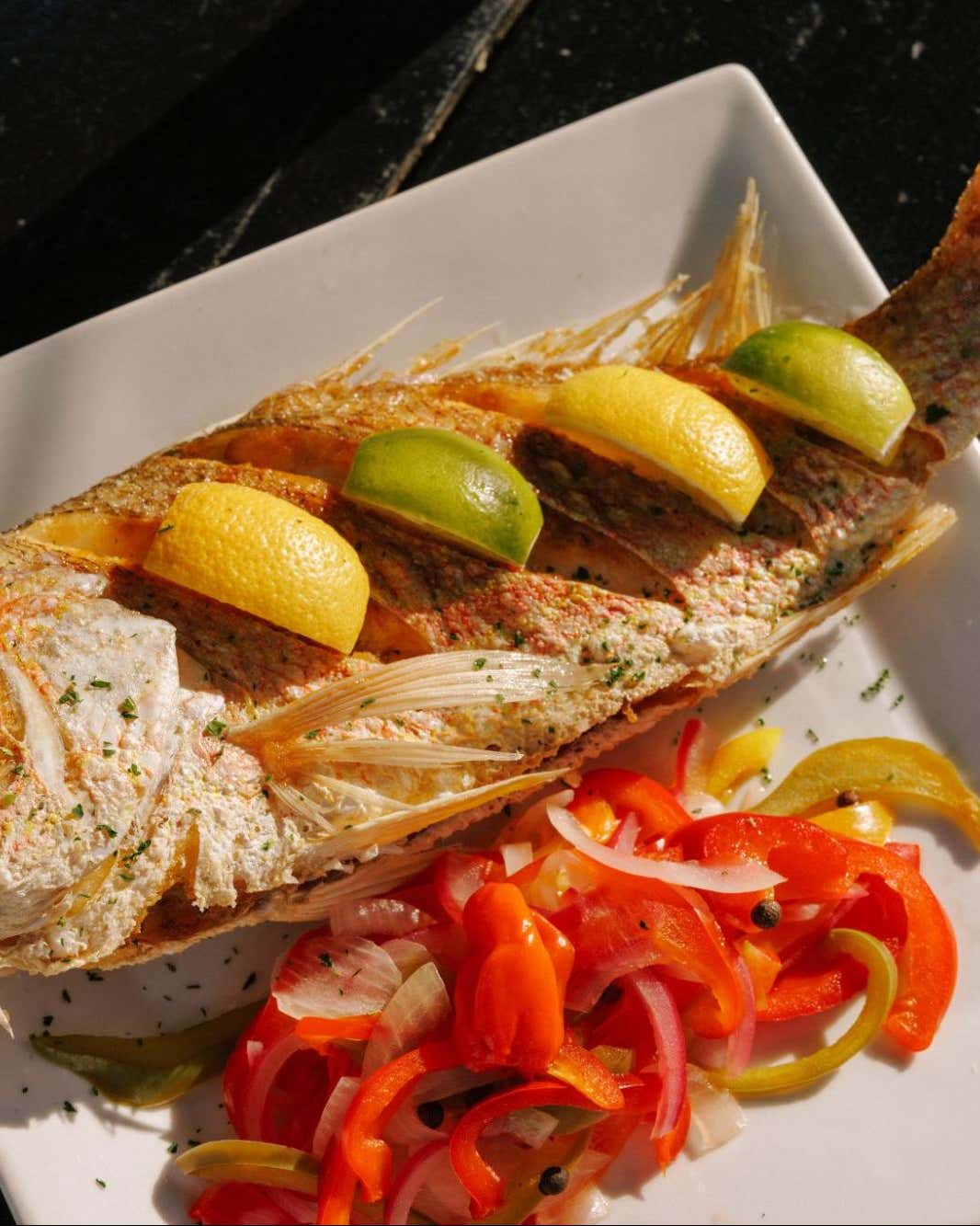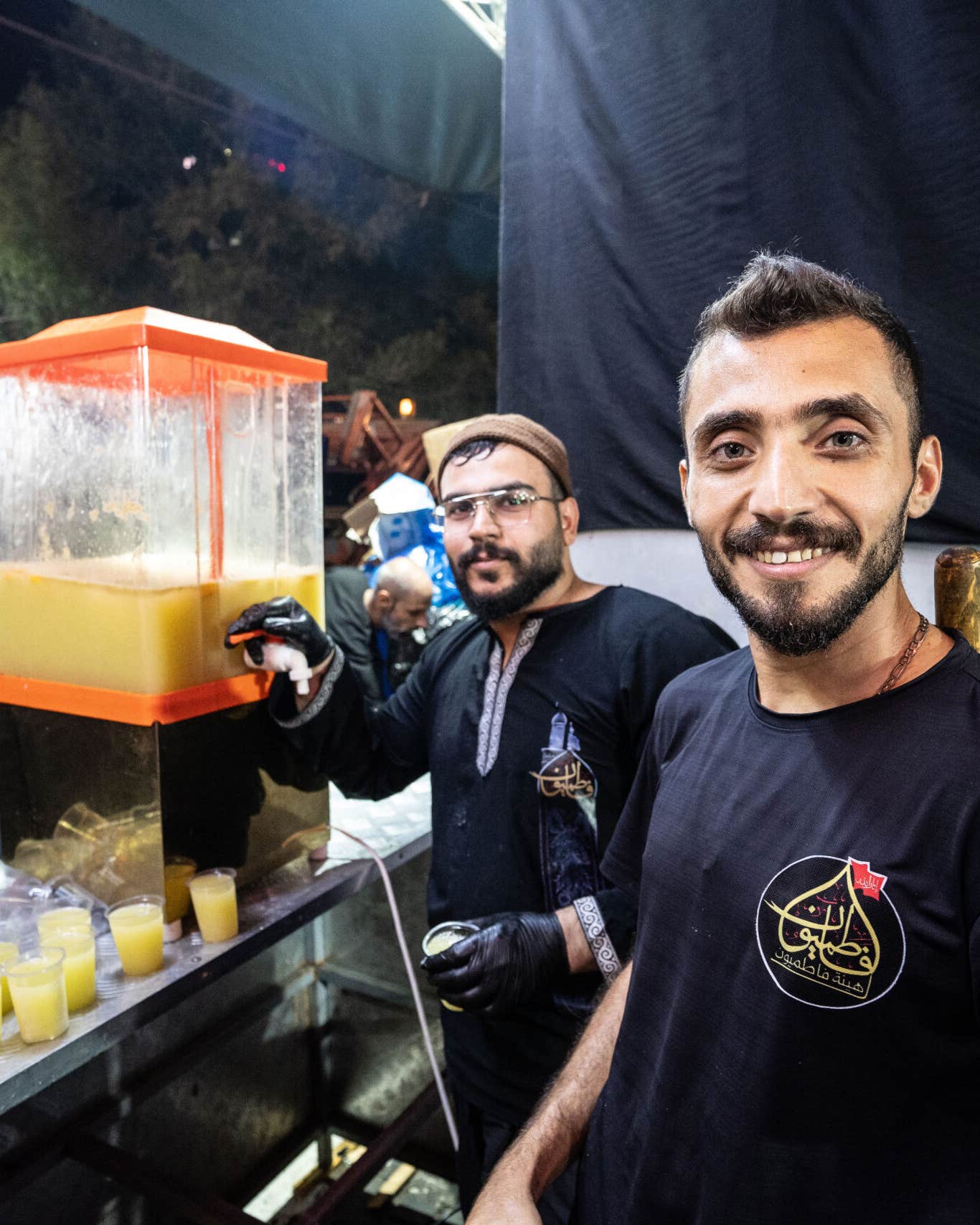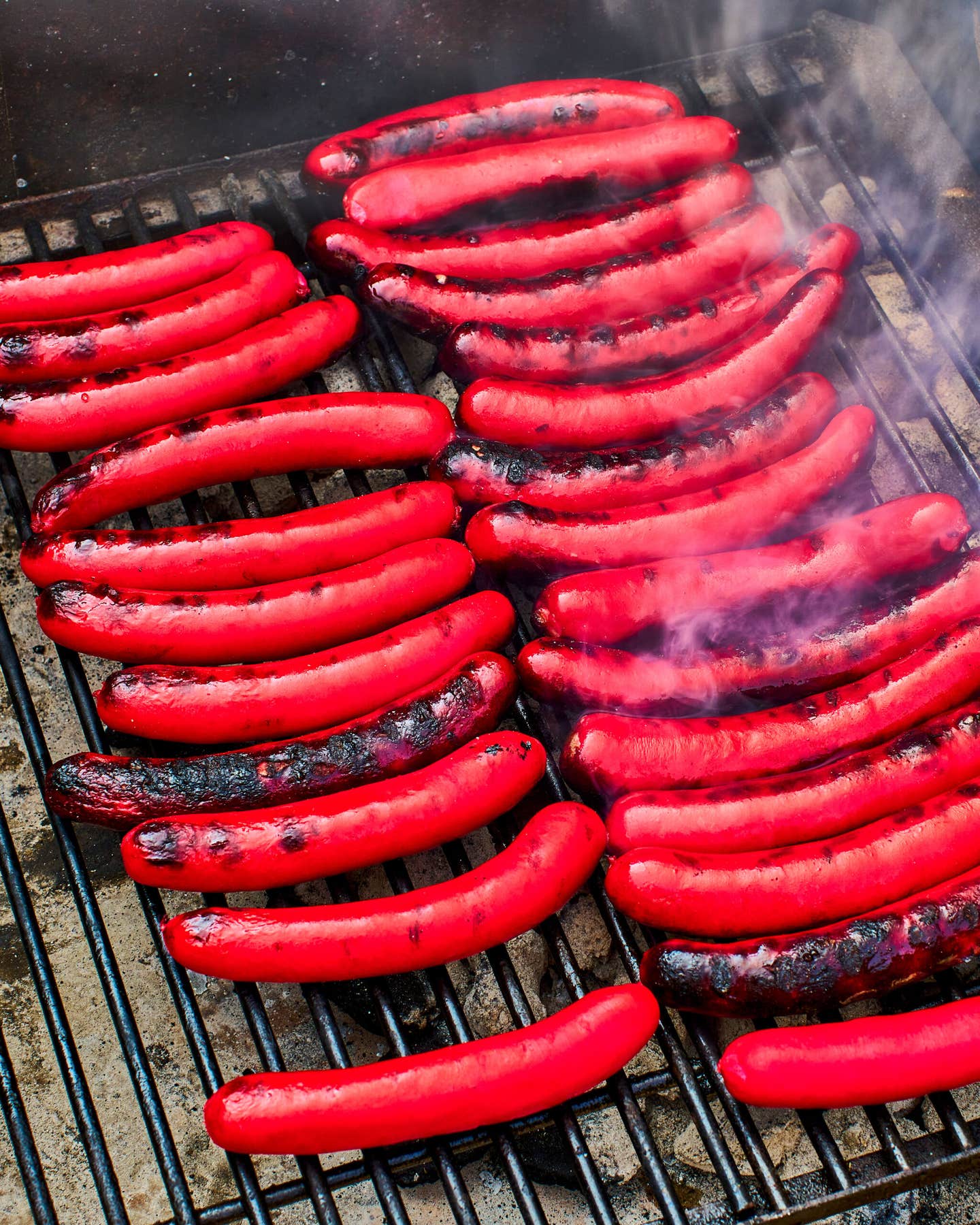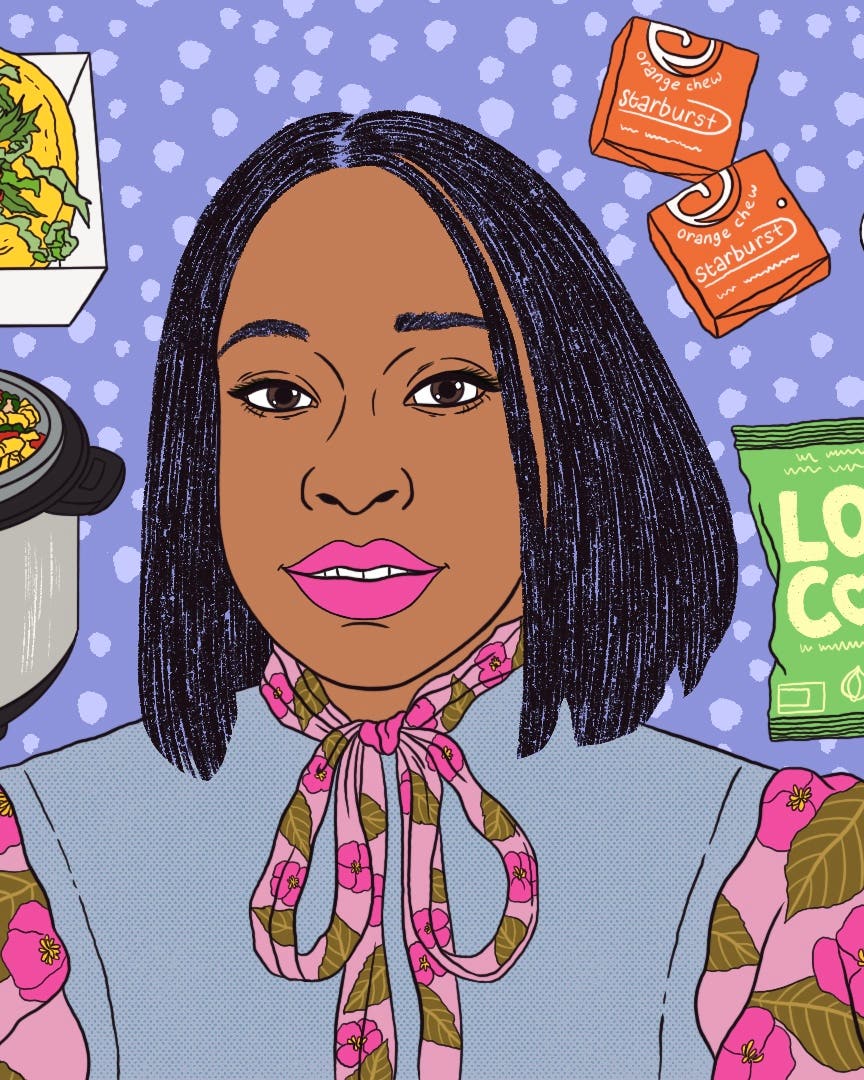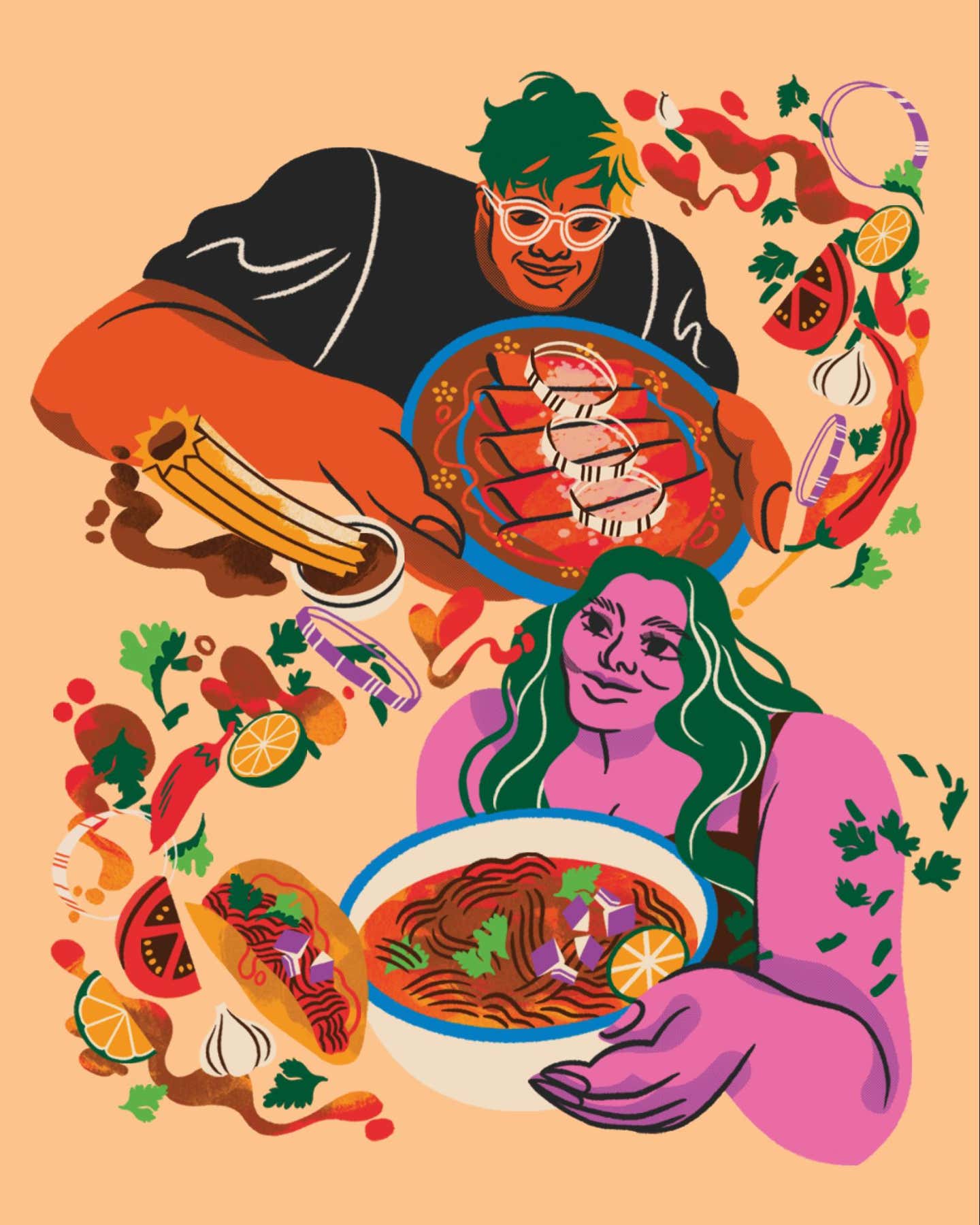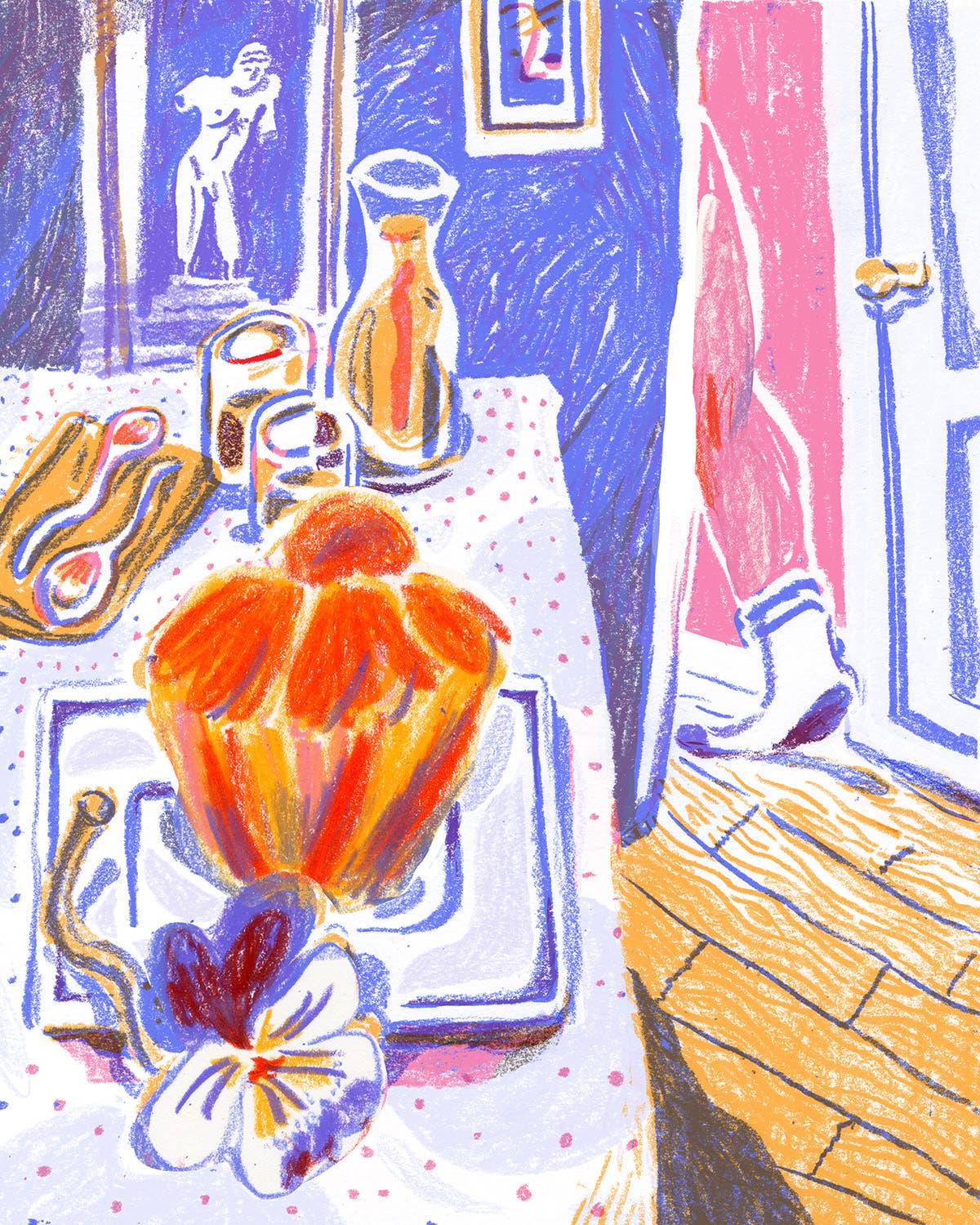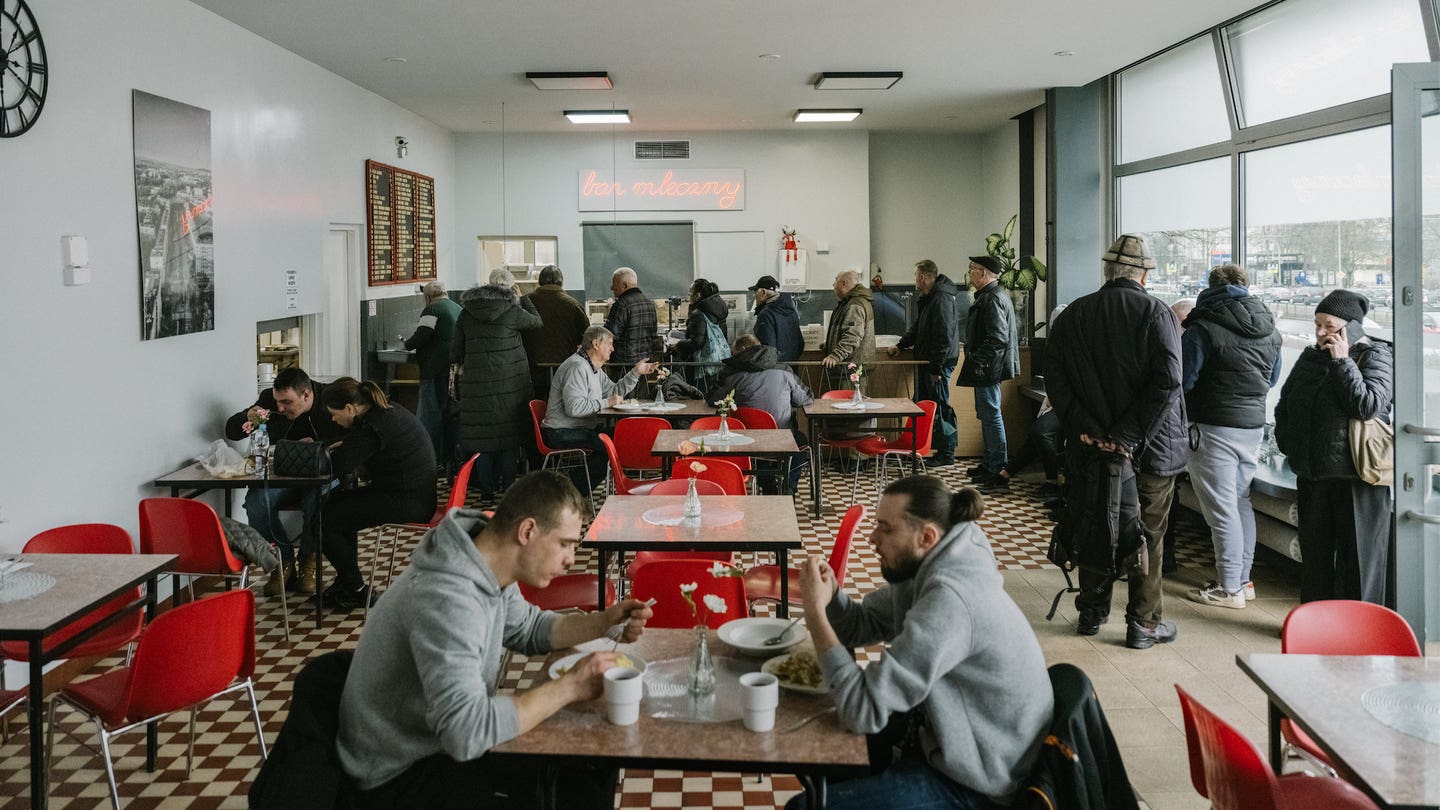
How to Take a Milk Bar Crawl Through Krakow
These history-soaked canteens serve Polish comfort food with a hefty side of nostalgia.
Krakow runs on milk bars. These no-fuss canteens serve affordable yet filling meals that taste like Babcia’s house—big, honking dessert and all—and they hold a deep, nostalgic place in Poland’s national psyche. While the country’s food scene has been sprinting in the opposite direction of hearty staples like żurek soup, schabowy pork cutlets, and pierogi ruskie (more on those later), milk bars have remained steadfast, soul-soothing, and as reliably satiating as ever.
In modern Poland, milk bars (“bar mleczny” in Polish) seem like an anachronism doomed to die out. Polish culinary school graduates aren’t clamoring to work at canteens, and the bars’ aging workers are retiring in droves. Even if the establishments were to survive, would they not be Brooklynized into kitschy brunch restaurants or turned into a franchise by yet another vulture fund?
Curious (and hungry), I went to Krakow to find out what the future holds for these treasured restaurants. That’s how I met Michał Turecki. Turecki is a born-and-raised Cracovian food guide, writer, and cook who—like many Poles—can trace life’s milestones back to milk bars. On a cloudy-turned-sunny April morning, I met him outside Bar Centralny. Two minutes into the conversation, he was already drifting into misty-eyed nostalgia: When his grandmother passed away seven years ago, he went straight to nearby Bar Północny to cry over a plate of pierogi ruskie because they reminded him of the ones she used to make.
Milk bars’ emotional connection has a lot to do with history, and the fact that they’ve been around for generations. While most associate this type of dining with post-World War II communism, it in fact predates the war. Turecki explains that milk bars grew in popularity in the 1950s, when getting inexpensive meals to the people was crucial as the country dealt with post-war destruction, social unrest, political uncertainty, and a litany of economic challenges. Turecki estimates there were once some 70,000 milk bars across the country.
One reason milk bars have survived is government subsidies, which make $3 żurek with kielbasa and $2 pierogi possible today. In an era when food insecurity is on the rise, it’s in Poland’s national interest to have a nourishing (in every sense of the word) alternative to ultra-processed calorie bombs and fast-food chains. And at milk bars, you can bank on the kind of meal a Polish mother or grandmother would serve—in part because that’s who’s predominantly in the kitchen. These establishments, then, double as a source of culinary dignity to those who would otherwise not be able to afford to eat well. Some patrons even bring containers to stock their fridges and cupboards.
It’s no secret that nearly all bar mleczny offer what’s basically a copy-paste menu of the classics. Nobody’s there for variety or aesthetically pleasing presentations prepared by stagiers moving grains of kasha around just so with a pair of tweezers. Rave reviews of milk bars often have more to do with sentimental value than taste, though Turecki insists that quality does vary depending on the cook.
But many cooks are nearing retirement. Turecki says he’s “terrified” about the future of milk bars. Beyond the meager salaries, the ever-dwindling pot of public money is another looming nail in the coffin. “Politicians think the main group using the milk bars are people with food stamps,” he says. “When actually, you can meet people there from almost every social group, from the poorest to students, and tourists.”
Konrad Piwowarczyk, who also joined me on my milk bar crawl, shares Turcecki’s sentiment. Piwowarczyk is a young, gregarious, wildly knowledgeable food and vodka guide with Delicious Poland. “They might be the type of business that will phase out with time,” he says.
But they won’t go down without a fight. The closure of a number of popular milk bars in recent weeks and months struck an alarming chord. Further, local elections are on the horizon in Krakow and funding milk bars has become a political football, drawing attention to the issue.
Then there’s the role of tourism. Krakow, with its UNESCO-protected old town, is a tourist magnet, and visitors are charmed by the kind of old-timey, traditional dining milk bars provide. As more middle- and upper-class Poles abandon milk bars for international options popping up around the city, it remains to be seen whether these enduring establishments will become a rare overtourism success story.
I couldn’t wait to be a tourist myself: Exploring the city’s milk bars is a wonderful way to experience the local culture and meet Cracovians from all walks of life. Armed with lists provided by Turecki and Piwowarczyk (and a Reddit page or two), I set off on an epic tour of 13 milk bars across the city. Here’s a taste of my findings.
Bar Mleczny Centralny
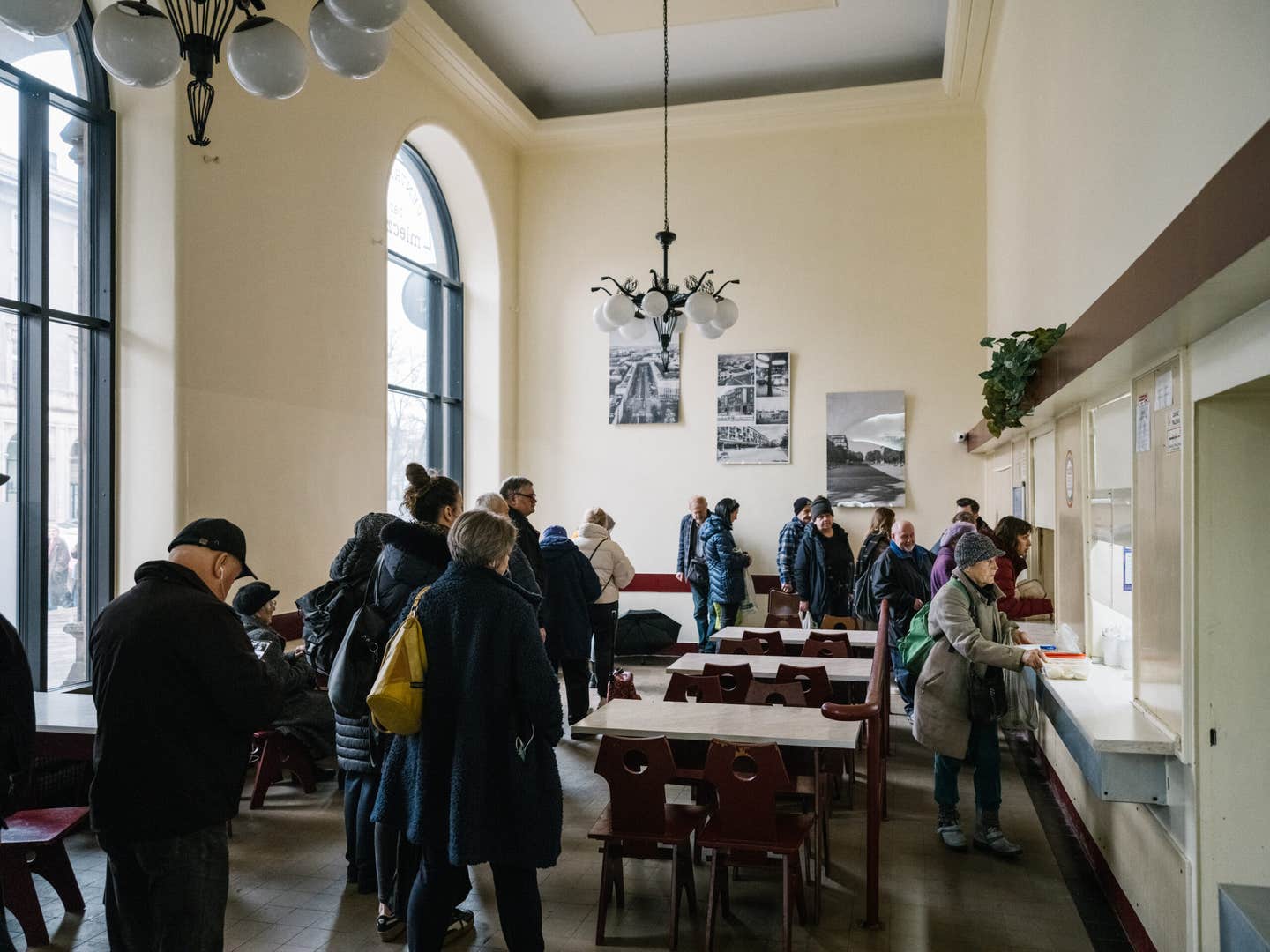
It’s breakfast time, so I get bułka z pastą jajeczną i kakao, half a bread roll with chopped hard-boiled eggs, mayo, and onions spread across. It comes with a piping-hot cup of cocoa, a less off-putting combination than it sounds. (Cocoa became a milk bar breakfast staple due to coffee shortages, according to Turecki.)
I love it in here: the white marble tables, maroon chairs, and unusually ornate chandelier twinkling over it all. We’re in Nowa Huta, literally the “new steel mill,” where a towering statue of Lenin once stood. The area was designed in the 1950s as the model communist neighborhood. Communism is long gone, but communist-era Centralny remains.
Bar Mleczny Północny
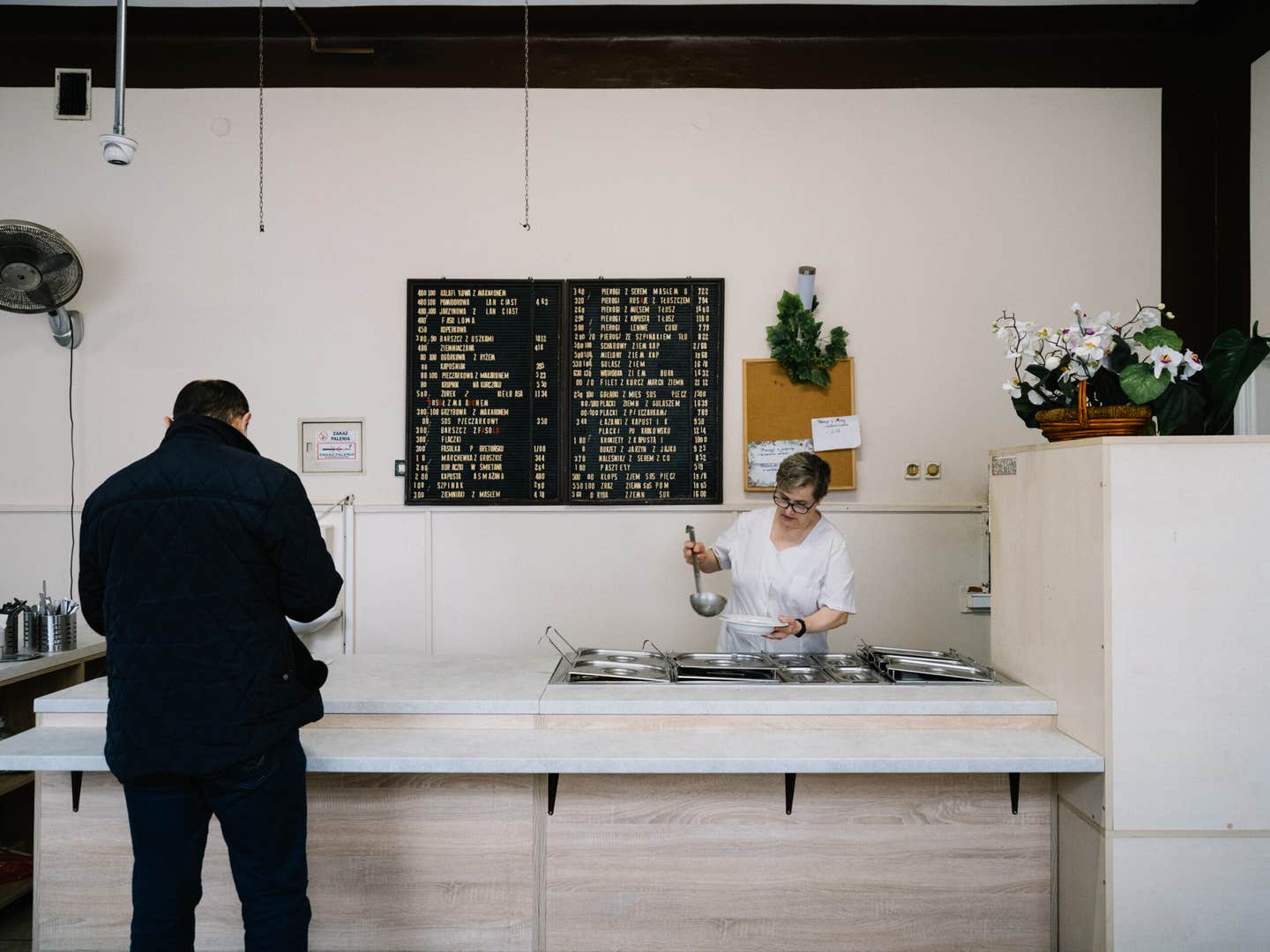
This is where Turecki cried over those pierogi ruskie, describing the experience as “metaphysical.” Stuffed with twaróg (smoky cow’s cheese) and sprinkled with chopped fried bacon, they’re everything I want in a pierogi––soft, slightly chewy, and tangy from the cheese.
An aside: Many presume “ruskie” relates to Russia, and some have taken to calling the dish pierogi ukraiński in protest. But “ruskie” is actually derived from “Rus,” in reference to the historical region of Red Ruthenia, which now straddles western Ukraine and southeastern Poland.
Turecki gets the kluski leniwe, or “lazy” dumplings. These are essentially pasta strips served with melted butter, a sprinkling of breadcrumbs, and sugar. Turecki explains that the generous use of sugar in milk bars dates back to post-war shortages of virtually everything but sugar. “There was a saying: sugar makes you stronger.”
Bar Mleczny Bieńczyce
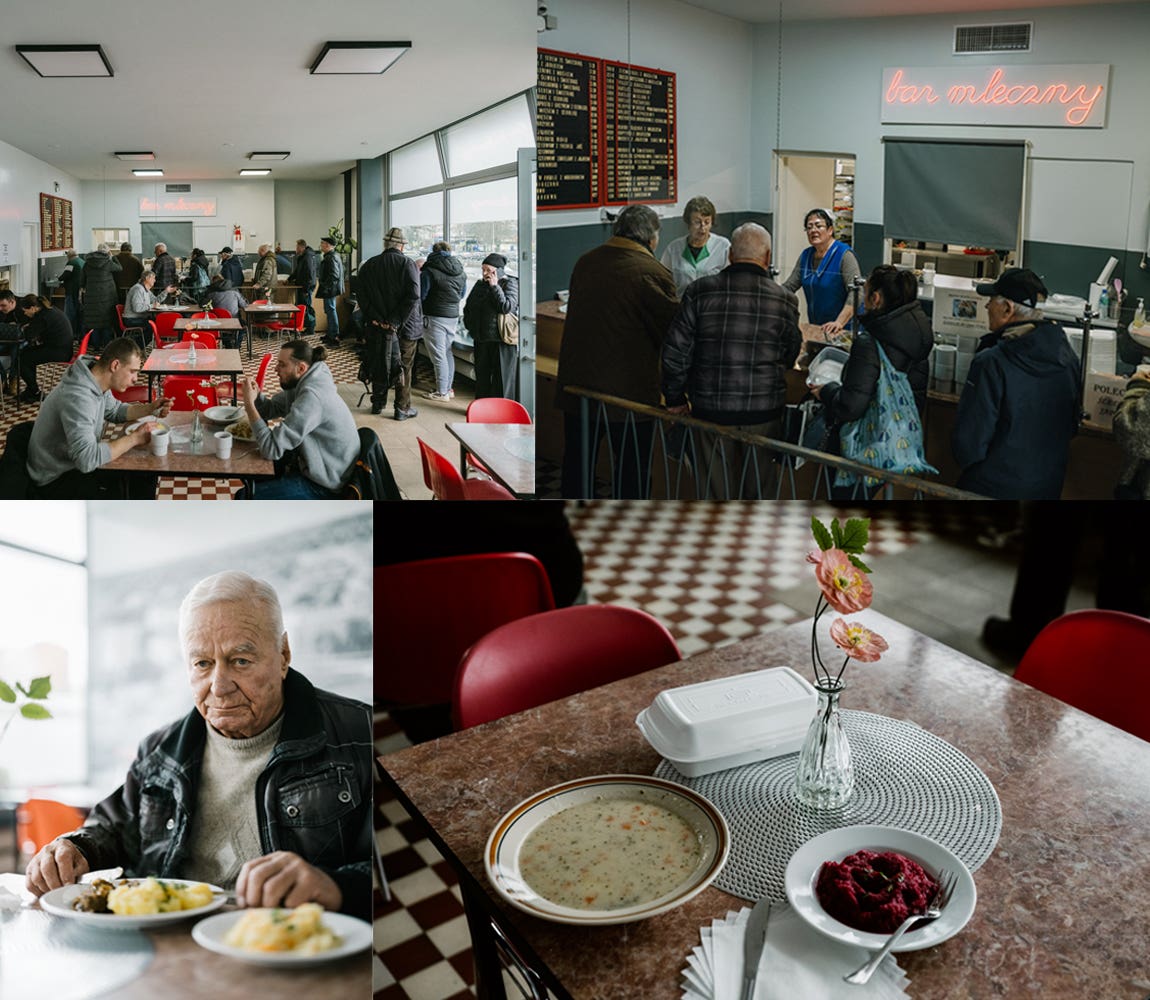
Bieńczyce’s is known for its soups, especially the thick and flavorful krupnik brimming with barley, carrots, celery, onions, and potatoes. The sour rye soup called żurek is also popular, made hearty by potatoes, hard-boiled eggs, and sausage. It’s available at every milk bar, but here it’s “just like it supposed to be,” Turecki says, “properly sour with good-quality sausage.”
Bar Mleczny Żaczek
Marble tables are bunched together to make room for the throngs of students, young professionals, and retirees queuing up at the doorway at this casual spot. I grab a seat while Turecki takes care of the order. What arrives is both sweet and savory: kopytka z masłem are hoof-shaped dumplings made from potato-based dough that come drizzled with melted butter. Turecki calls these “Polish gnocchi” for their pillowy texture. Then, it’s naleśniki z jabłkami, pancakes with a tart apple filling. A far cry from your fluffy American pancakes, we’re talking burrito-size blintzes covered in an avalanche of powdered sugar. (Remember, sugar makes you strong.)
Bar Mleczny Uniwersytecki
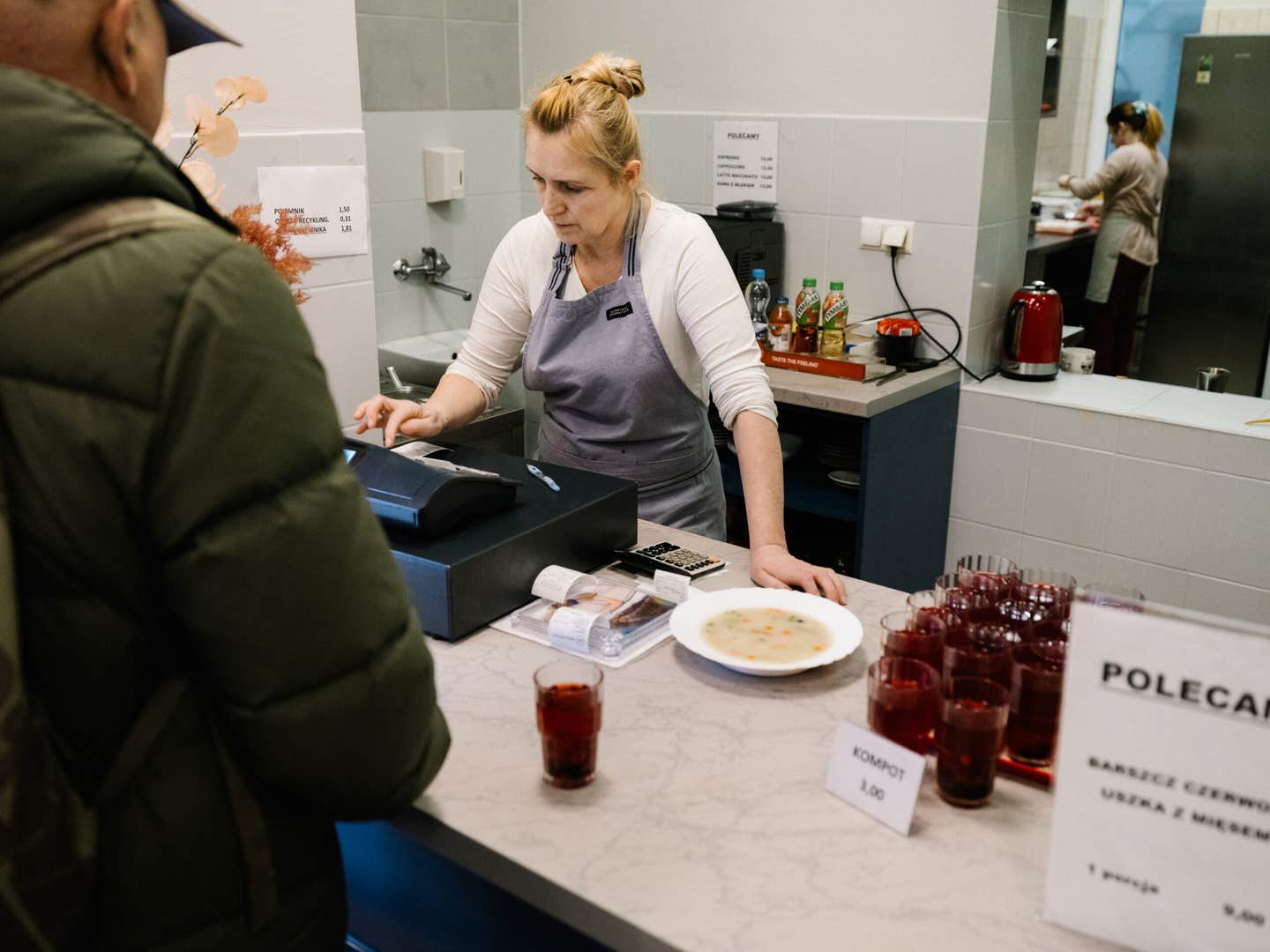
Uniwersytecki, literally “University,” is a student lunch stalwart, but people of all ages flock here for placki ziemniaczane z sosem, potato pancakes with gravy. While most meat eaters spring for hunter’s sauce (shallots, mushrooms, butter, demi-glace), my vegetarian sensibilities point me to a steamy mushroom gravy with soft porcini mushrooms swimming in the cloudy glaze.
MIŁA Bar Mleczny
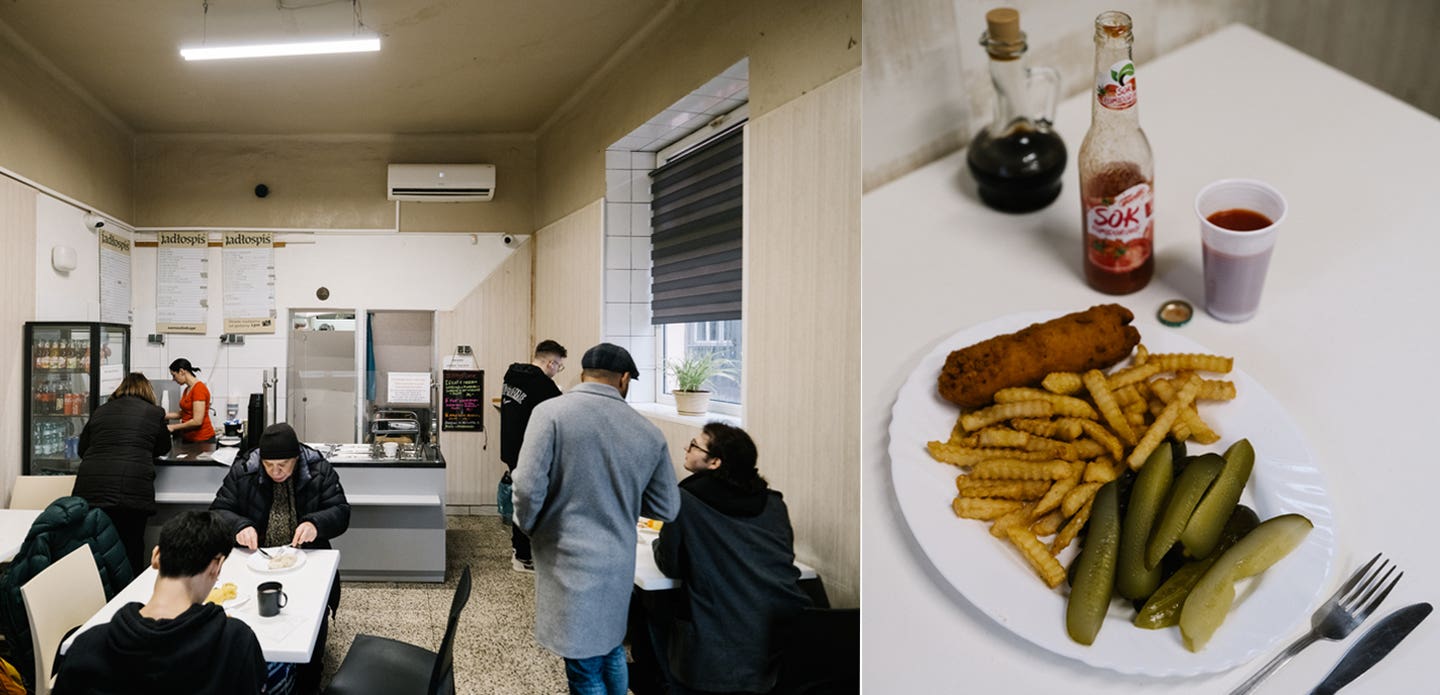
We pop into this hole-in-the-wall for a quick bowl of żurek, that sour rye soup. It’s lukewarm and has a salty, meaty flavor that reminds me of shrink-wrapped American hotdogs. I don’t love it, but I’m clearly in the minority judging by the line trailing out onto the sidewalk.
Bar Mleczny Krakus
Krakus, near the Jewish Ghetto Memorial and Oskar Schindler’s factory, is one of the few milk bars with an English menu on the counter. I glance over it while Turecki helps a gaggle of Spanish tourists communicate their order.
Before I know it, I’m tucking into an excellent bowl of barszcz czerwony z uszkami, hot and tangy beet soup with small mushroom-filled dumplings. The dish is popular on Christmas Eve (Wigilia), so it’s a rare treat to be having it out of season. I follow it up with racuchy z jabłkami, pancakes with a slight pan-fried crunch that ooze apple compote with every bite.
Bar Mleczny Jutrzenka
Jutrzenka is tucked into a community block across from a tree-covered park. The typically long menu is plastered with three Pepsi logos, a vestige of the excitement for western products when communism fell.
It’s breakfast, so time for another eggy bread roll. Here you get the other half of the roll, so you can eat it like a sandwich. The egg, mayo, and onion mix comes together more like a salad than one congealed paste. With a shake of fresh pepper, it’s good to go.
Bar Mleczny Targowy
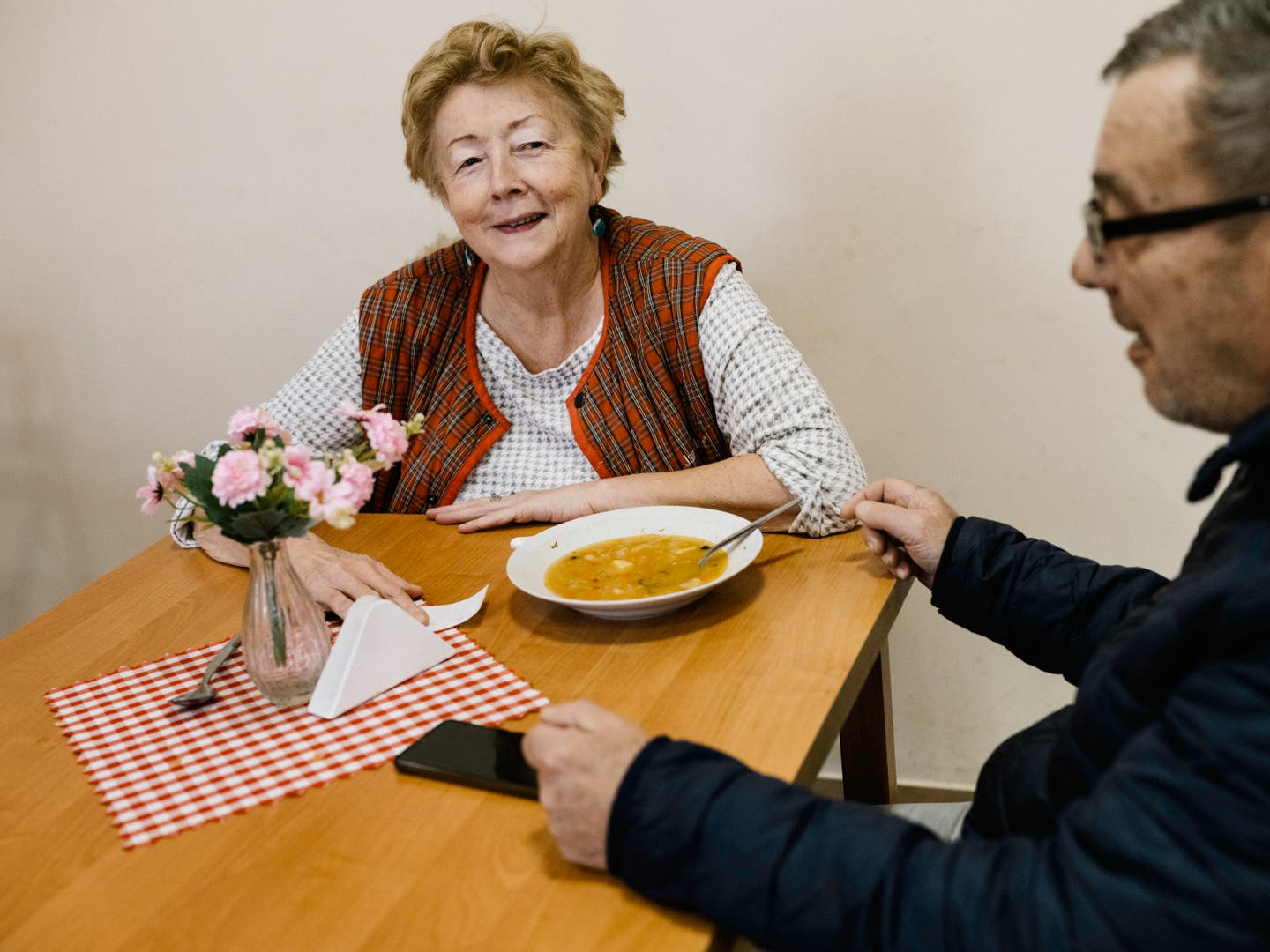
Targowy, on a wide communist-era boulevard, feels homey with laminate mock-wood flooring and matching tan chairs and tables, a vibe that carries through to a menu of old-school classics like kotlet schabowy, bigos (hunter’s stew with chopped meat, sauerkraut, and fresh cabbage), and—as always—pierogi ruskie.
Piwowarczyk orders us a plate of naleśniki z serem, twaróg cheese-stuffed pancakes, which are usually dessert. These are what a Polish dessert “ought to be,” according to him—sweet but not overpoweringly so.
Bar Mleczny Pod Temidą
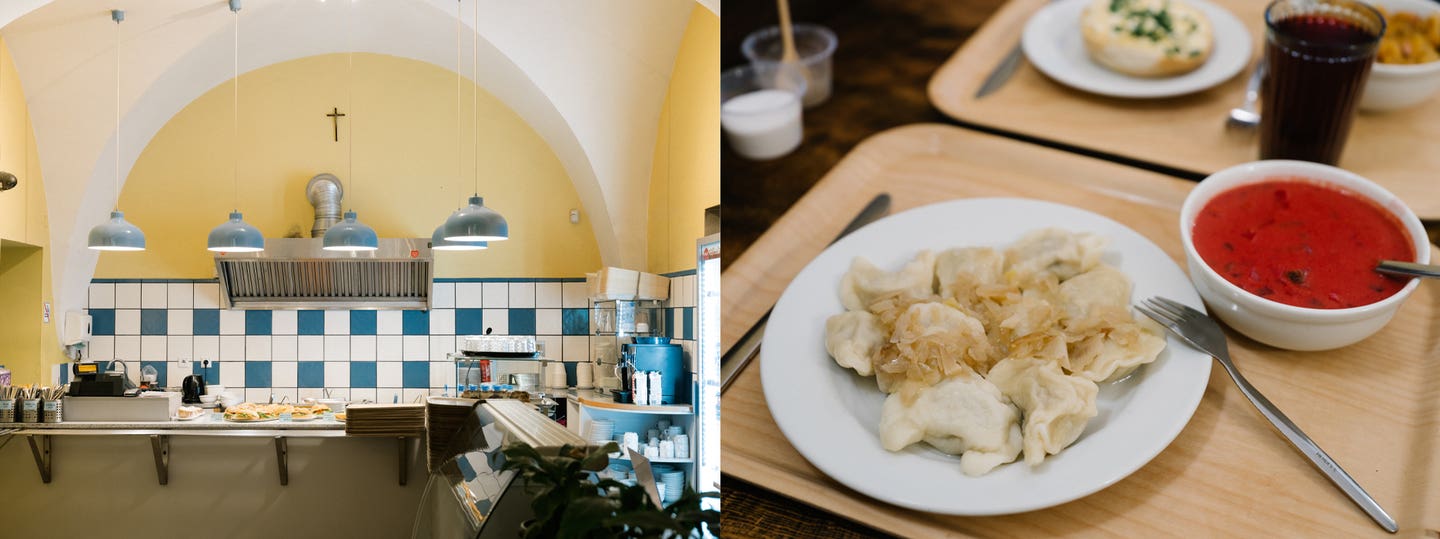
Temidą is the only true bar mleczny in Krakow’s old town, which means it’s busier and pricier than the others on the list. But who am I to complain about an $8 pork cutlet? The canteen is worth a stop for its interiors alone, low-vaulted ceilings reminiscent of a medieval palace entrance. But the spirit of simplicity remains in dishes like kluski śląskie (Silesian dumplings) served on a plastic lunch tray. These deliciously glutinous gut bombs swimming in a creamy mushroom sauce have a subtle potato flavor and a slightly chewy, dense consistency thanks to the potato starch.
Bar Mleczny Smakosz
Smakosz peeks through a lush living wall of greenery (at least during the summer). Turecki suggests a cozy bowl of rosół, Polish chicken soup with a crystal-clear broth;
noodles like strands of shredded paper; and fresh vegetables like carrots, celery, and onions. It reminds me of what my grandmother would make me as a kid when I was under the weather; I’m not surprised to learn it’s Poland’s natural remedy for colds and flu, too.
Bar Mleczny Pod Filarkami
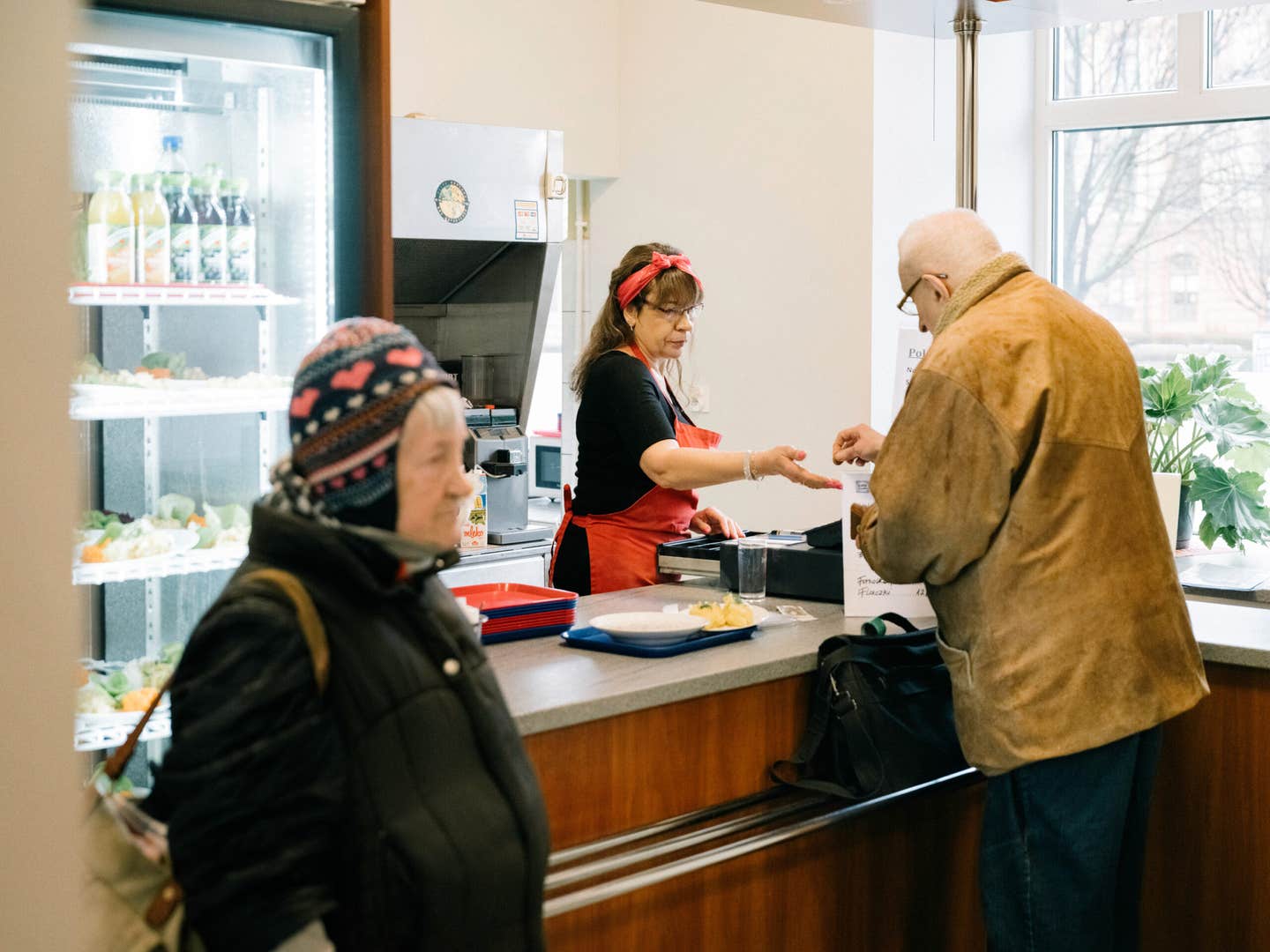
Filarkami, straddling the old town and Kazimierz, feels like a rustic tavern with its faux-brick walls and wooden tables. But the blue plastic trays transport me back to canteen land. Piwowarczyk goes for the kotlet schabowy, a breaded and fried boneless pork cutlet that’s Poland’s answer to wiener schnitzel. “It’s crispy and not too dry—with a bit of moisture yet not overly oily,” he says. It comes with an earthy-smelling grated beet salad that wasn’t what he actually ordered. But like Seinfeld and the Soup Nazi, it’s best to avoid confrontation when dealing with the no-nonsense milk bar ladies.
Meanwhile, I devour my kasha covered in yet another creamy mushroom sauce that shares the plate with a different beet salad enriched with butter and cream and wash it all down with a mug of tangy kefir. The beet-kefir combo transports me instantly to the Polish countryside.
Bar Mleczny Flisak
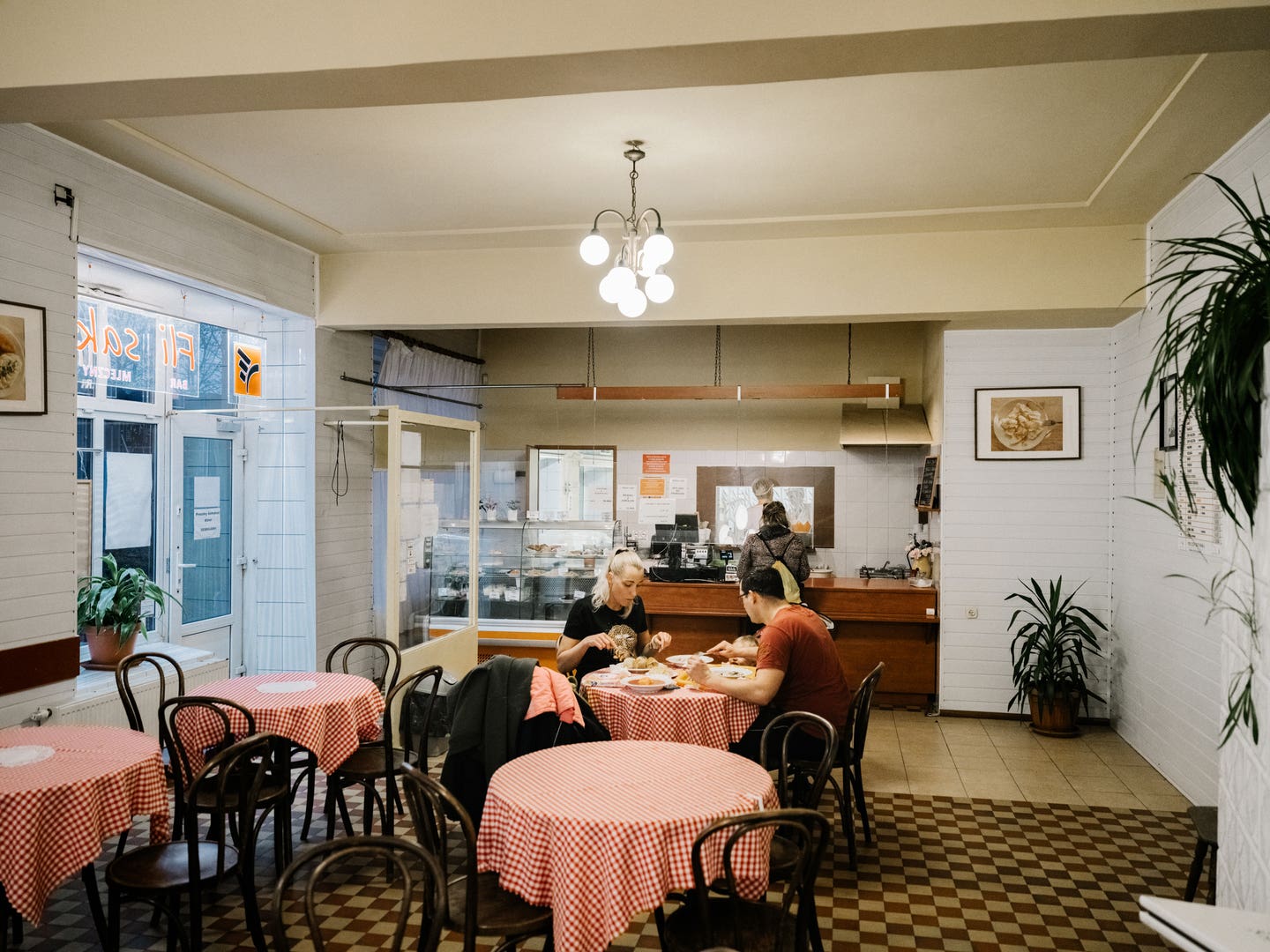
Occupying the bottom floor of a blocky building with graffiti between the window and entrance, Filsak feels about as far from 2024 as you can get. The trattoria-style red-and-white checkered tablecloths brighten up the joint; so does the food, which feels slightly lighter. The pierogi ruskie aren’t overly doughy, which lets the subtle cheese, potato, and black pepper filling be the star. I try some ogórki kiszone (pickles) on the side, and they pack a tart, salty punch due to their brine in saltwater instead of vinegar. Dessert comes next: ryż z jabłkami, rice with apple, cinnamon, and sweet cream. It isn’t trying to win points for presentation, but it’s surprisingly harmonious—the sweetness of the powdered sugar tempers the acid in the apples, and the grains of rice add textural interest.
Keep Reading
Continue to Next Story
